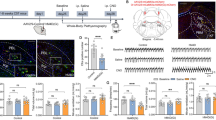Summary
Unilateral partial extirpation of the cerebellar nuclei produces asymmetry of electrical activity in all investigated parts of the central nervous system (telencephalon, diencephalon, mesencephalon, and cerebellum). The manifestations of this asymmetry are given below.
-
1.
In cortical areas 1–8 and 12, and also in the caudate nucleus, contralateral to the lesion, the amplitude of potentials is decreased and their frequency increased. In the cortex of the homolateral hemisphere, an increase in amplitude of the potentials is observed. This dissociation of frequencies and amplitudes in the right and left hemispheres is manifestly maintained or, conversely, strengthened during generalized inhibition caused by injection of thiopental sodium (25 mg/kg) and during diffuse activation following administration of armin (0.5–0.25 mg/kg) or arecoline (0.3 mg/kg). Total disappearance of spindles or a marked weakening of spindle-like rhythms is observed in the cortex and basal ganglia of the contralateral hemisphere.
-
2.
In the medial thalamic nuclei and mesencephalic reticular formation the amplitude of high-frequency (beta- and gamma-) waves on the side of the lesion is increased by comparison with their amplitude on the intact side.
-
3.
Against the background of diffuse armin activation, the higher electrical activity in the neocortex of the contralateral cerebellar hemisphere is clearly visible.
Removal of the cerebellar nuclei leads to disappearance or depression of the important function of the nonspecific thalamo-cortical system generating spindle-like activity in physiological sleep or light barbiturate anesthesia.
Similar content being viewed by others
References
ARBUZOV, S. Ya. and M. I. NIKIFOROV. Systemic Nervous Narcosis. Meditsina, Leningrad, 1967.
ARBUZOV, S. Ya. and M. I. NIKIFOROV. Present State of the Theory of Narcosis. Kirov Military Medical Academy, Leningrad, 1967.
FANARDZHYAN, V. V. Regulatory Mechanisms of the Ascending Influence of the Cerebellum. Armenian SSR Academy of Sciences, Erevan, 1966.
FANARDZHYAN, V. V., A. S. AMATUNI and M. V. KHANBABYAN. Zh. Vyssh. Nerv. Deyatel'nosti im I. P. Pavlova. 15:1079, 1965.
CANESTRARI, R., P. CREPAX and X. MACHNE. Arch. Psicol. Neurol. Psychiat. 16:19, 1955.
CREPAX, P. and E. FADIGA. Arch. Sci. Biol. 10:66, 1956.
MOLLICA, A., G. MORUZZI and R. NAQUET. Electroencephalogr. Clin. Neurophysiol. 5:571, 1953.
MORUZZI, G. and H. MAGOUN. Electroencephalogr. Clin. Neurophysiol. 1:455, 1949.
STOUPEL, N. Contribution Expérimentale à l'Étude des Relations Cérébello-Cérébrales. Brusselles, 1962.
WALKER, A. J. Physiol. (London) 90:39, 1937; J. Neurophysiol. 1:16, 1938.
Author information
Authors and Affiliations
Rights and permissions
About this article
Cite this article
Nikiforov, M.I., Gorodnik, A.G. & Avramovich, V.M. Electroencephalographic changes after unilateral partial extirpation of cerebellar nuclei. Neurosci Behav Physiol 2, 925–930 (1968). https://doi.org/10.1007/BF01124741
Issue Date:
DOI: https://doi.org/10.1007/BF01124741




